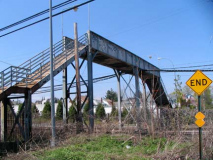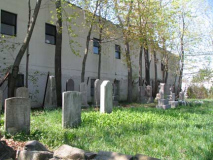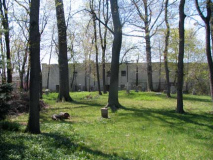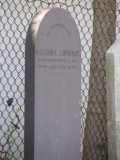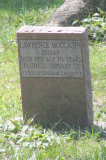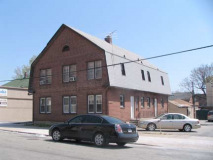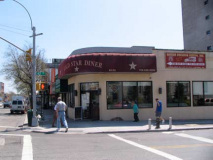With more free time during the week (after a 3/23/11 layoff) but still pretty much shackled to Queens because of usurious transit fares (I do not drive, but the usurious gas prices would further shackle) I have found myself stalking the roads of Queens even more than before, now that the weather has marginally improved. The last week of April, I walked 42nd Avenue in Bayside, past the newspaper office where I had previously worked (that was a layoff as well, after heart surgery and the takeover of the paper by an Australian news mogul) but also past a funeral ground that had been owned by the same family for 300 years and pleasant 20th Century architecture.
At 42nd Avenue and 216th Street, there’s a gated, open green space with a rickety-looking pedestrian bridge spanning the Long Island Rail Road. We’ll discuss the space later– meanwhile this fragile pedestrian bridge (lit by a pair of pipes with sodium lamps attached, abetted the past few years by two cobra neck streetlamps) is one of those out of the way oddities preserved simply because they’re in out of the way neighborhoods, largely off the radar. The bridge was first constructed in 1924 and has been fighting chipping concrete and rust ever since.
While complaints about the bridge’s condition first surfaced in 1993, The Department of Transportation have been passing the buck back and forth about who needs to repair it and maintain it, with the predictable result that not much has happened. The DOT decided to repair it in 1998, and some shoring up and the addition of the two streetlights happened, and various scenarios that have turned up since have the bridge repaired; torn down with a replacement; and torn down without a replacement. In April 2011 it’s still there.
The green space, meanwhile, is the Lawrence Family Burial Ground, which had been owned by the wide-ranging Lawrence family of Queens County since the plot was granted by the family by New Amsterdam Governor William Kieft in 1645. The plot became a cemetery in the mid-1830s (when the first stones appear) with the last burial occurring about a century later.
Famous people buried in the old graveyard include Cornelius Van Wyck Lawrence (1791-1861), Mayor of the City of New York (1834-37). His grave is marked by a shaft in the form of an obelisk. County Judge Effingham Lawrence’s gravesite is designated by a rectangular stone, set on a stepped-up base. Other members of the Lawrence family interred here include Colonel Frederick Newbold Lawrence who served in the Civil War and was later president of the New York Stock Exchange from 1882- 83, and Mary Nicolls Lawrence, second wife of Mayor Andrew H. Mickle of the City of New York. Bayside Historical Society, which maintains the cemetery
At left, one of the non-members of the Lawrence family, Lawrence Moccasin, the manservant of Judge Effingham Lawrence.
This gambrel roofed house just east of Bell Boulevard may once have been a farmhouse. At the SE corner of 42nd Avenue and Bell Boulevard is the Gold Star Diner, where your webmaster took his meals every Tuesday night before working at the newspaper for about 6 or 7 years. It is a small railcar-style diner that has apparently been in business since the 1960s. (Super fast, large portions, which is what my unsophisticated palate wishes from a restaurant).
Chase, previously Bank of New York, SE corner 42nd Avenue and Bell Blvd. The architecture looks modernist, could be late 1920s at the earliest, 1940s at the latest. There’s no dated cornerstone, but a clue might be the bronze eagle with the “Locally Owned” sign.
The small brick building at 41st Road and the south side of the LIRR is a former freight transfer building, a reminder of the era when the LIRR carried a lot of freight in addition to passengers. At right, a modern sign obscures some 1920s terra cotta work. With the chimney on the south platform of the Long Island Rail Road on 41st Road off Bell Boulevard is a former freight transfer building, a relic of the days when the LIRR carried freight as well as passengers. Across Bell Boulevard, modern signage tends to detract from the intricate terra cotta work of a building that likely goes back to the 1920s.
On this 1909 Bromley map, 42nd Avenue and its center mall (which runs from Francis Lewis Boulevard east to 213th Street) has already been mapped as Palace Boulevard. 43rd Avenue was originally Lawrence Boulevard, named for the Lawrences who owned a lot of property in Bayside and throughout Queens.
The Clearview Expressway, I-295, was constructed from 1957 to 1963, and like many of Robert Moses’ highway projects, was forced through despite community opposition. It provides a north-south route for trucks that the Cross Island Parkway does not, but its southern run ends at Hillside Avenue and the Grand Central Parkway (which trucks cannot enter). Many of the Clearview’s pedestrian walkways still have their original church-like light stanchions. The fences to prevent bikes from speeding onto the service roadway are recent additions.
West of the Clearview the center mall resumes on 42nd Avenue, which becomes a Tudor wonderland in spots. The North Shore Baptist Church at 202nd Street is a handsome ranch-style building built in 1948. Unusually, the steeple is mounted on the front lawn, not on a spire.
The center median on 42nd Avenue is much lusher and more wooded west of the Clearview. A now relatively rare twin double-mast lamppost is found near 202nd Street.
The 1930s vintage PS 130, and its 1965 addition (PS Q130, the Early Childhood School for Science and Technology, at 42nd Avenue andFrancis Lewis Boulevard.
The boulevard, the longest in Queens, runs from Whitestone south to Rosedale. It was called Cross Island Boulevard until, presumably, Cross Island parkway was built in the 1930s, and was named for the Welshman by birth (1713-1802), New Yorker by immigration, and as a delegate to New York’s constitutional convention in 1774, signer of the Declaration of Independence two years later.
West of Francis Lewis Boulevard, 42nd Avenue loses its center mall and runs as a two lane road west to Auburndale Lane. At 194th Street is some new construction that is about as good as it gets for housing of this vintage (even the trees were left standing!) At left is evidence of a new city initiative to discard the early 1960s Donald Deskey lampposts, as parts for them are no longer available.
About five years ago [2006] the city also started to replace fire alarm lights, which had been roughly the same for about six decades, with new “top hat” luminaire-mounted models. At right is evidence of the impracticality of the formerly-used model — the orange plastic diffuser bowl has to be held in place by tape.
Louie’s Luncheonette at the corner of 42nd and 192nd Street appears to have been here for several decades, just a block south of the Auburndale Long Island Rail Road station. 42nd Avenue runs past Utopia Parkway just before this stretch of it ends at Auburndale Lane.
Utopia Parkway is one of Queens’ most picturesquely-named streets. The Utopia Land Company acquired about 50 acres here in June 1905 and planned to build a cooperative development for Jews then living in the Lower East Side. The company ran out of money and the area was never developed according to plan, but the streets that were laid out were absorbed into Queens’ street layout. The development has another legacy: Utopia Parkway, constructed north to south in stages from Whitestone south to the Grand Central Parkway in Jamaica Estates. It was completed in the 1940s.
“Utopia” was invented by Sir Thomas More for his 1516 book Utopia, describing a fictional island in the Atlantic Ocean. The term has been used to describe both intentional communities that attempted to create an ideal society, and fictional societies portrayed in literature. It has spawned other concepts, most prominently dystopia. wikipedia
Probably Utopia Parkway’s most notable resident was artist Joseph Cornell (1903-1972), many of whose “shadow boxes” made of found materials and everyday objects can be found in the Museum of Modern Art and his notes at the Smithsonian Archives of American Art.
5/10/11


